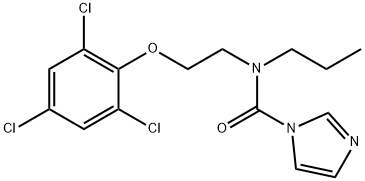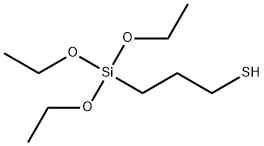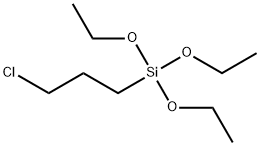Prochloraz
- CAS NO.:67747-09-5
- Empirical Formula: C15H16Cl3N3O2
- Molecular Weight: 376.67
- MDL number: MFCD00078735
- EINECS: 266-994-5
- SAFETY DATA SHEET (SDS)
- Update Date: 2025-12-07 19:09:50

What is Prochloraz?
Chemical properties
Off-White to Light Tan Solid
The Uses of Prochloraz
Prochloraz is a protectant and eradicant fungicide effective against a wide range of diseases affecting field crops, fruit, turf and vegetables. It is recommended for use on cereals against Pseudocercosporella, Pyrenophora, Rhyncosporium and Septoria spp. and on oilseed rape against Alternaria, Botrytis, Pyrenopeziza and Sclerotinia spp. When it is applied as a dip treatment it shows good activity against storage or transit diseases of citrus and tropical fruit. It is also used as a seed treatment to control several diseases of cereals.
The Uses of Prochloraz
Plocloraz is used as a fungicide. Plocloraz showed efficacy against cereal powdery mildew.
What are the applications of Application
Prochloraz is a fungicide often showed to have great efficacy against cereal powdery mildew
Definition
ChEBI: A member of the class of ureas that is 1H-imidazole-1-carboxamide substituted by a propyl and a 2-(2,4,6-trichlorophenoxy)ethyl group at the amino nitrogen atom. A fungicide active against a wide range of diseases affecting field crops, ruit, turf and vegetables.
Agricultural Uses
Fungicide: Plocloraz is fungicide that has shown to be effective against cereal powdery mildew. Not approved for use in EU countries. Not registered for use in the U.S. There are 26 global suppliers.
Trade name
ASCURIT®; BTS40542®; DIBAVIT®; EYETAK®; FORTAK®; FUNCHLORAZ®; GRAIL®; MASTER®; MIRAGE®; MIRAGE® 40 EC; PORAZ®; SPORGON®; SPORTAK®; SPORTAKALPHA®; SPORTAKDELTA®
Metabolic pathway
Prochloraz is metabolised in plants and animals and degrades in soils. The initial step in the metabolic pathway is cleavage of the imidazole ring; the substituted ureas that result are subsequently degraded to moieties containing a chlorophenoxy residue and the ring is hydroxylated. Residues may be conjugated in animals and plants.
Degradation
Prochloraz is stable in water at pH 7 and 20 °C. It decomposes on exposure to sunlight and is also decomposed by concentrated acids and alkalis.
Properties of Prochloraz
| Melting point: | 46-49°C |
| Boiling point: | 360℃ |
| Density | 1.405 |
| vapor pressure | 1.5 x l0-4 Pa (25 °C) |
| refractive index | 1.6490 (estimate) |
| Flash point: | 2 °C |
| storage temp. | Sealed in dry,2-8°C |
| solubility | DMF: 30 mg/ml; DMSO: 30 mg/ml; Ethanol: 30 mg/ml; Ethanol:PBS(pH 7.2) (1:1): 0.5 mg/ml |
| form | Solid |
| form | neat |
| Water Solubility | 34.4 mg l-1 (25 °C) |
| pka | 3.8 (weak base) |
| color | White to Light yellow to Light orange |
| Merck | 14,7760 |
| BRN | 8155344 |
| CAS DataBase Reference | 67747-09-5(CAS DataBase Reference) |
| NIST Chemistry Reference | Prochloraz(67747-09-5) |
| EPA Substance Registry System | Prochloraz (67747-09-5) |
Safety information for Prochloraz
| Signal word | Warning |
| Pictogram(s) |
 Exclamation Mark Irritant GHS07  Environment GHS09 |
| GHS Hazard Statements |
H302:Acute toxicity,oral H410:Hazardous to the aquatic environment, long-term hazard |
| Precautionary Statement Codes |
P273:Avoid release to the environment. |
Computed Descriptors for Prochloraz
| InChIKey | TVLSRXXIMLFWEO-UHFFFAOYSA-N |
New Products
4,4-Difluoropiperidine hydrochloride tert-butyl 9-methoxy-3-azaspiro[5.5]undecane-3-carboxylate Indole Methyl Resin N-Isopropylurea N,N-Dicyclohexylcarbodiimide(DCC) MELDRUMS ACID 5-METHYLISOXAZOLE-4-CARBOXYLIC ACID Magnessium Bis glycinate Zinc ascorbate 1-bromo-2-butyne 2-acetamidophenol 9(10H)-anthracenone Erythrosin B, 4-Piperidinopiperidine 2-((4-morpholinophenylamino) (methylthio) methylene) malononitrile 2,4-dihydroxybenzaldehyde 3-(4-morpholinophenylamino)-5-amino-1H-pyrazole-4-carbonitrile Methyl 2-methylquinoline-6-carboxylate 2,6-dichloro-4-nitropyridine 4-Bromo-2-chlorobenzonitrile 2-(benzylamino)acetic acid hydrochloride 4-(tert-Butoxycarbonylamino)but- 2-ynoic acid 3,4-dihydro-2H-benzo[b][1,4]dioxepine 1-Phenyl-1-cycloprppanecarboxylicacidRelated products of tetrahydrofuran








You may like
-
 Prochloraz CAS 67747-09-5View Details
Prochloraz CAS 67747-09-5View Details
67747-09-5 -
 Prochloraz 98% (GC) CAS 67747-09-5View Details
Prochloraz 98% (GC) CAS 67747-09-5View Details
67747-09-5 -
 Prochloraz CAS 67747-09-5View Details
Prochloraz CAS 67747-09-5View Details
67747-09-5 -
 Prochloraz CAS 67747-09-5View Details
Prochloraz CAS 67747-09-5View Details
67747-09-5 -
 3-(4-amino-1-oxoisoindolin-2-yl)-1-methylpiperidine-2,6-dione 98%View Details
3-(4-amino-1-oxoisoindolin-2-yl)-1-methylpiperidine-2,6-dione 98%View Details -
 20677-73-0 (2,2-diethoxyethyl)methylamine 98%View Details
20677-73-0 (2,2-diethoxyethyl)methylamine 98%View Details
20677-73-0 -
 3-(4-(hydroxyamino)-1-oxoisoindolin-2-yl)piperidine-2,6-dione 98%View Details
3-(4-(hydroxyamino)-1-oxoisoindolin-2-yl)piperidine-2,6-dione 98%View Details -
 57381-49-4 2-bromo-4-chlorobenzonitrile 98%View Details
57381-49-4 2-bromo-4-chlorobenzonitrile 98%View Details
57381-49-4
